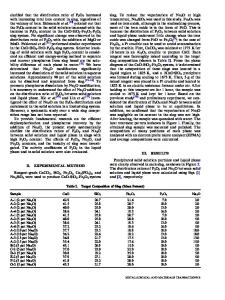Chemical potentials of components of the system CaO + P 2 O 5 + Fe x O at 1673 K
- PDF / 790,938 Bytes
- 9 Pages / 612 x 792 pts (letter) Page_size
- 73 Downloads / 347 Views
L
INTRODUCTION
T H E removal of phosphorus from liquid iron can be expressed as 2P (in Fe) + (5/2) 02 (g) = PzO5 (in slag)
[I]
or
2P (in Fe) + 5 Fe~O (in slag) = P205 + 5x Fe (1)
[2]
The general conditions to enhance the dephosphorization reaction have been well delineated. These are low temperature, high oxygen potentials (high FexO activities), and low P205 activities. To meet these requirements, slags used for phosphorus removal normally contain appreciable amounts of CaO and FexO. While Reaction [2] proceeds to the righthand side, P:O5 is formed within the slag. Hence, at the final stages of dephosphorization, slags would consist of CaO, Fe~O, and P205. From the foregoing comments, it is evident that a better understanding of the phosphorus reactions relies on a knowledge of the thermodynamic properties of the system CaO + P205 if- Fe,O. In the present study, the activities of Fe~O in CaO + P2Os + FexO slags were determined at 1673 K by employing an electrochemical technique involving stabilized zirconia, t~-~SJ The galvanic cells used in this study can be expressed as Mo / Mo + MOO_, / ZrO2 (MgO) / Fe (s) + Fe,0 (in slag) / Ag / Fe The phase diagram of the system CaO + P205 + FexO has been well established. The isothermal section at 1673 K based on the work of Tromel and co-workerstt6,~71 is given in Figure I. Although the absence of the solid solution is assumed, it may extend from the CaO apex to the temary field. The isothermal section consists of the following regions: (1) (2) (3) (4) (5)
homogeneous liquid; CaO + liquid, region A-CaO-B-A; CaO + Ca4P2O 9 -t- liquid, triangle CaO-B-C~P; Ca4P20,~ + liquid, region C4P-C-B-C4P; Ca4P_.O9 + Ca3PzO8 + liquid, triangle C4P-C-C3P;
HIDEAKI HOSHINO, Doctorate Student, and MASANORI IWASE, Professor. are with the Department of Energy Science and Engineering, Kyoto University, Kyoto 606-01, Japan. Manuscript submitted January 4, 1995. METALLURGICALAND MATERIALSTRANSACTIONS B
two liquids, triangle C3P-C-D; (7) two liquids, region C-E-D-C; (8) Ca3PzO8 + liquid, region C3P-D-F-C3P; (9) Ca3P208 + two liquids, triangle C3P-F-G; (10) two liquids, region G-H-F-G; and (11) Ca3P2Os + liquid, region C3P-G-I-C3P. (6) Ca3P20 s +
In addition to these regions, two-phase assemblages of triangles C3P-C-D and narrow to be illustrated in Figure 1. Hereafter, the following notations are used: C = CaO, C4P = Ca4P209, C3P = Ca3P2Os, and L = {CaO + P205 + FexO} liquid ternary slags. During experimental runs, slag compositions were changed along the five broken lines shown in Figure 1. All the lines pass through the FexO apex; CaO/P205 mole ratios are fixed at 96/4, 90.9/9.1 (=10/1), 78/22, 71.4/28.6 (=5/2), and 66.7/33.3 (=2/1). C3P q- liquid should exist between C4P-C-C3P , although this area is too
II.
EXPERIMENTAL ASPECTS
The experimental apparatus and procedures have been described elsewhereY -~51An iron crucible was charged with 20 to 30 g of the slag and about 35 g of pure silver and heated to 1673 K in a stream of purified argon inside a SiC resistance furnace. The dispo
Data Loading...











